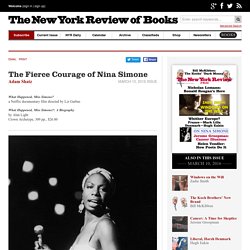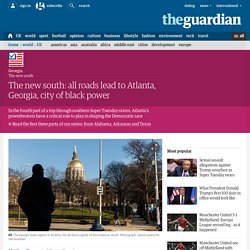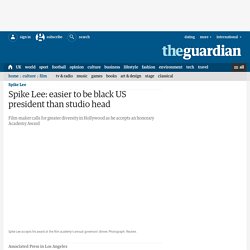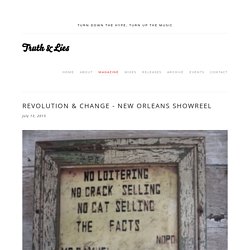

Lost cities #10: Fordlandia – the failure of Henry Ford's utopian city in the Amazon. In 1928, northern Brazil was captivated by an enticing bit of news.

The region’s residents were about to receive a new visitor, a man who came with the promise of reviving their ailing economy and introducing them to a whole new way of life – Henry Ford. Local papers began raving about their future neighbour. The Fierce Courage of Nina Simone by Adam Shatz. What Happened, Miss Simone?

A Netflix documentary film directed by Liz Garbus What Happened, Miss Simone? : A Biography by Alan Light Crown Archetype, 309 pp., $26.00 In 1968, an interviewer for New York public television asked the singer and pianist Nina Simone what freedom meant to her. How we made Public Enemy's Fight the Power. Hank Shocklee, producer During the disco boom, the money was flowing so crazy that even the messengers were riding in limos – and then the business crashed.

Bands couldn’t afford a drummer or a bass player and that’s how rap was born: we’d build tracks from samples of records. But even when we were bigger than R&B and rock groups, we could barely get our videos shown – just once a week, on Yo! MTV Raps. The new south: all roads lead to Atlanta, Georgia, city of black power. There’s a joke southern people tell about the Georgia capital.

Purgatory, they call it. San Francisco, then and now. 1.

Gold rush abandoned ships 1849: Vessels lie abandoned in San Francisco Bay. Whole crews discarded their ships for the gold fields. They were eventually salvaged for their wood and furnishings. Seen from the south end of Yerba Buena Cove toward Telegraph Hill, this is one of the oldest known photographs of San Francisco. 2. August 1873: Inventor Andrew Hallidie (1836-1900) tests the first cable car system near the top of Nob Hill at Clay and Jones streets. 3. Poorest town in poorest state: segregation is gone but so are the jobs. Tchula’s chief of police was drifting into sleep at the desk of his sparsely furnished office.

Billy Reed had been describing what it was to run a department with so little money it relied on hand-me-down patrol cars still bearing the markings of other forces. The cars were sitting out back, not far from where the drug dealers loitered. One had bullet holes in the wing and a windscreen with a starburst crack. Another stayed parked at night because the lights didn’t work. Spike Lee: easier to be black US president than studio head. Spike Lee has told an audience of entertainment luminaries that it is easier for a black person to become US president than head of a Hollywood studio or network.

Lee made the remarks on Saturday as he accepted an honorary Oscar at the film academy’s annual governors awards dinner in Hollywood, where Gena Rowlands and Debbie Reynolds were also honoured. “We need to have some serious discussions about diversity and get some flavour up in this,” he said. Black power’s coolest radicals (but also a gang of ruthless killers) The right to bear arms that is enshrined in the US constitution is now most fiercely defended by rightwing libertarians. But it wasn’t always the case. In the mid-1960s, that decade of revolt and turmoil, Huey Newton, a 24-year-old law student in Oakland, California, realised that citizens of that state had the legal right to carry arms openly.
A teenage thug who taught himself to read, Newton had consumed revolutionary literature from Marx to Malcolm X and had become, in his early 20s, a political activist bent on promoting the rights of his fellow African Americans. Revolution & Change - Detroit 1968 — TRUTH & LIES. FRIDAY 23 OCTOBER 2015, ROUGH TRADE NOTTINGHAM 6.30 - 11pm.

FREE ENTRY. In the early morning hours of July 23, 1967, one of the worst riots in U.S. history breaks out on 12th Street in the heart of Detroit’s predominantly African-American inner city. By the time it was quelled four days later by 7000 National Guard and U.S. Army troops, 43 people were dead, 342 injured, and nearly 1,400 buildings had been burned. By 1968 Detroit was in a period of middle class (Black and White) flight, Nixon was about to be elected and the city had it’s latest Olympic bid fail. Revolution & Change - New Orleans Showreel — TRUTH & LIES. Revolution & ChangePost Katrina New OrleansShow Reel Main EventFriday 17 July at Rough Trade6.30 - 11pm On August 29th 2005, New Orleans was hit by one of the worst hurricanes in American history. 80% of New Orleans was flooded with some areas up to 4.8 metres underwater.

Over half a million people were evacuated. One of the first truly multicultural cities in the USA and the birthplace of Jazz was devastated. Revolution and Change presents a snapshot of the music and art before and after this event and provides inspiration for change on a local and national level. “Aux Etats-Unis, l'intervention de l'Etat est considérée comme immorale” ‘A rocket up the backside of conformity’ - how Allen Ginsberg’s Howl transformed pop. Voyagez dans les photos d'archives de la Grande Dépression américaine depuis une carte interactive. C'est un véritable voyage que vous propose de vivre l'université américaine de Yale : celui d'explorer les Etats-Unis tels qu'ils étaient entre 1935 et 1944, durant la Grande Dépression, à l'aide de plus de 170 000 photos d'archives organisées sur une carte interactive.

Ces milliers de photographies sont accessibles via la position géographique où elles ont été prises. Organisées sur la carte, il est donc possible de les découvrir en sélectionnant l'état, la ville ou même le quartier de la prise de vue. Le moteur de recherche vous permet également de parcourir les archives selon leur date ou même selon le photographe qui les a prises. Nouveau rapport accablant sur la gestion des émeutes de Ferguson par la police. Les forces de l’ordre doivent être mieux entraînées et plus vigilantes afin d’éviter de répéter les erreurs commises lors des émeutes de Ferguson en 2014 aux Etats-Unis.
En ayant recours à des chiens ou des blindés, la police de cette ville du Missouri n’a fait qu’amplifier les tensions après la mort de Michael Brown, un Noir de 18 ans tué par un policier blanc il y a un an, selon un rapport du ministère de la justice américain publié jeudi 3 septembre. Relevant que plus de 50 entités de maintien de l’ordre avaient été impliquées dans les opérations de sécurisation de la ville après la mort du jeune homme, le ministère dénonce dans son rapport de près de 200 pages, qui se concentre sur les 17 jours ayant suivi le drame, « un commandement incohérent » et une « communication lacunaire » entre les différents acteurs. Chiens, gaz lacrymogènes et tireurs d’élite. New Black Panthers documentary tells the story behind the berets. The Black Panther Party for Self-Defense was founded in Oakland, California, in 1966 by Bobby Seale and Huey Newton, two activists with southern roots who had both been involved with the civil rights movement.
The pair’s political leanings allied more with the militancy of Malcolm X than the nonviolent methods of Martin Luther King, and a central pillar of their ideology, outlined in an ambitious 10-point program, was the necessity for their community to defend itself, bearing arms, against harassment and brutality by the city’s predominantly white police force. Though the Panthers launched as a local concern, chapters soon sprang up nationwide against the backdrop of the era’s burgeoning countercultural politics (Vietnam, the student movement); a global confluence of anti-colonial movements; and the toxic social and economic results of de facto segregation. The Panthers offered young, disenfranchised African Americans a sense of refuge and communal purpose.
Police in Ferguson gave a lesson in how not to respond to protests, says report. The police response to unrest in Ferguson, Missouri, last summer offers lessons in how not to handle mass demonstrations, according to a Justice Department report that warns such problems could happen in other places roiled by mistrust between law enforcement and the community. The report fleshes out a draft version made public in June, creating a portrait of poor community-police relations, ineffective communication among the more than 50 law enforcement agencies that responded, police orders that infringed first amendment rights, and military-style tactics that antagonized demonstrators.
The final version, which is to be released on Thursday, was obtained in advance by the Associated Press. The report focuses on the regional police response in the 17 days that followed the 9 August 2014 shooting of Michael Brown, an unarmed black 18-year-old, by a white police officer. Several law enforcement agencies whose actions were studied said they have learned from the events.
Big yellow taxi: a history of New York City's cabs – in pictures. Katrina timeline - Urbain, trop urbain. Atchafalaya Basin Bridge - Urbain, trop urbain. L’interstate 10 de Baton Rouge à Lafayette est une longue traine de béton jumelée que les ingénieurs ont suspendue au-dessus du bassin versant de l’Atchafalaya river. Les bayous ondulent sous ces lignes parallèles brutales dont on peine à reconnaître qu’il s’agit d’un pont, l’un des plus grands au monde.
Wilderness is a resource which can shrink but not grow… the creation of new wilderness in the full sense of the word is impossible. Aux Etats-Unis, le mont McKinley n’existe plus. C’est la fin du mont McKinley, le point culminant des Etats-Unis. Etats-Unis : un symbole des Etats confédérés déboulonné au Texas. Au cœur de l’université du Texas, à Austin, près de l’emblématique horloge qui caractérise le lieu, une figure des Etats confédérés est tombée. Sign of the times: how Show Me a Hero captures our political mood. David Simon’s new series Show Me a Hero provides everything you might expect from a TV-maker with The Wire, Homicide: Life on the Street and Treme on his résumé. This adaptation of Lisa Belkin’s non-fiction book about Nick Wasicsko – a former cop who, in 1987, unexpectedly became mayor of Yonkers after running as a populist outsider – has, in the established Simon style, dialogue so real that it feels as if it was peeled off the street, and period images so richly composed that they could be auctioned at Sotheby’s.
(It’s a sign of the high production values that the director is Oscar-winning Hollywood auteur Paul Haggis.) Another Simon strength on display is his sense of the shape that best fits a particular tale. While The Wire was an epic five-decker novel of a show, meticulously exploring every inch of one city, Show Me a Hero is a rare American example of the six-part drama format that has traditionally been the province of the British.
Nouvelle Orleans. From literary heavyweight to lifestyle brand: exploring the cult of Joan Didion. Maybe every writer is doomed to have their tritest sentence become their most-tweeted, but in Joan Didion’s case, it feels particularly unfair that “we tell ourselves stories in order to live” has become so ubiquitous. The line begins the eponymous essay of 1979’s The White Album, titles her volume of collected non-fiction published in 2006 and now is the name of a forthcoming Kickstarter-funded documentary, directed by her nephew, Griffin Dunne. Its most terrifying stranglehold, though, is online, where it spawns and respawns itself across social media platforms.